Not so long ago, at a Coorg wedding, you could be fairly sure of whom you would meet and what you would eat. With a strong cup of coffee that said ‘welcome’, you browsed through a lavish choice of handcrafted sweets, savouries and deep fried snacks passed around on battered rectangular aluminum trays, or perched invitingly on a rustic wooden table covered in white, the cloth already splotched with stains from too eager helpings. You generally knew the hand that had created the food.
In these times of inexhaustible Internet cooking advice and a glut of catered snacks, it is difficult to imagine how women would spend a decade – or a lifetime – perfecting a special homemade wine, burfi or toffee. Myths and legends swirled around these sweet cheeses, fudges, snacks, wines and squashes and the women who created them. There was a sort of wonder in the way the details of texture and clarity were discussed by the fortunate ones who had tasted these offerings. Everything had an identity – it was never just coconut toffee, but Bollu’s Coconut Toffee; never ginger wine, but Muthu’s Ginger Wine. These women stamped their personalities on their creations and quite rightly, claimed the foods they created. Recipes were, understandably, very hard to come by, as the ladies were reluctant to part with hard won culinary secrets. The only time you could taste these handcrafted beauties was at in homes of those particular cooks, if you happened to be friends, or if a gift came your way. Then there were weddings. Women took great pride in making gifts of their specialties at events like weddings and babies’ naming ceremonies. This was how an elaborate food exchange was set in motion; bottles, jars and boxes were deposited with the mother of the bride or groom, to be served to wedding guests; but some of all of this was set aside, and in a gesture of reciprocity, the ladies were offered a selection of little luxuries other than their own to take away – and so the foods travelled from home to home.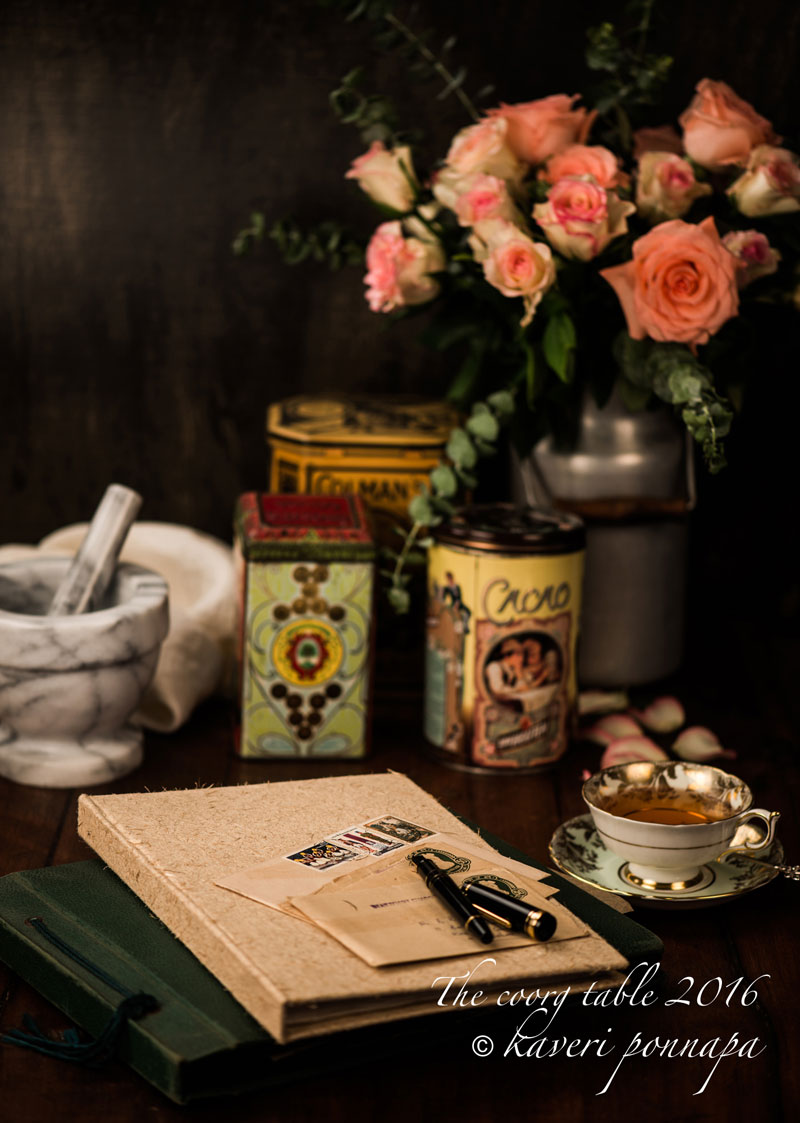
Even if you were not part of the inner circle, chances were you would have picked up enough advance information from pre-wedding conversations to know which relatives and friend had sent batches of their ‘specials’ for the event. So you planned your moves with care, not accepting the first wine or sweets that came your way, but looking out for your favourites, tagging them and following the progress of the tray so that you could slake your unrequited longing for a particular rich, sweet, confection, secreting a few squares in the folds of your embroidered handkerchief to carry back home to share, or linger over in privacy.
People enjoy weddings for different reasons. I loved them first for the music and dance: who could not be moved by the wild, desolate call of the Coorg horn? I loved the line of straight-backed, elegant grandmothers in their beautifully coordinated headscarves; the way strangers and unfamiliar faces were asked to account for themselves and were then introduced around, setting off Chinese whispers of shared information; the sense of community – and the food.
At these gatherings – because that is what they were, so much more than just an event – an intricate web relationships, delicately strung together with invisible threads would float to the surface: of family, near and distant, friends, and people who fitted somewhere in between. Tasks were assigned with much careful thought – it was an honour to be invited to take charge of even the most mundane chores. Suddenly, ordinary people around you were transformed: they became lamp-bearers and bridesmaids; bearers of wedding baskets; greeters of the groom’s entourage; masters of ceremonies and leaders of rituals. Ripples of community were formed and dissolved again and again, bonds reinforced, forgotten kinship reclaimed. Everything was responsibility and privilege, presided over by an armada of handsome, formidable, headscarf clad matriarchs who carried enormous bunches of keys tucked into their waistbands or jackets, decided what went on the tables when, and watched over every move with an eagle eye.
In an era before caterers, wedding planners and event managers, a compact, close knit clan and extended family and friends met to work together. A day before the wedding, you would find dozens of women, most of them related through kinship or friendship, seated at rough wooden tables surrounded by heaps of vegetables, cutting chopping and peeling. This was one of the biggest storytelling sessions in the region where gossip, old tales, and every possible kind of news were exchanged with a great deal of laughter to make everything go around.
The act of eating in a crowd at a wedding only seemed to make sense if you looked at it through the lens of community; seated on a long wooden bench, a neighbour on either side, a washed plantain leaf ready before you on a high wooden table, the food was served in a recognizable sequence by members of the family and clan moving between the long rows of tables, hauling enormous pots of curries, rice, pulaos and pickles. Everyone began to eat together, waiting for a signal, and leaving the table was bound by etiquette. The same flotilla of matriarchs, assisted by men of the clan, conducted everything without pausing for breath, over the din and clatter of metal, shouted instructions and non-stop conversation.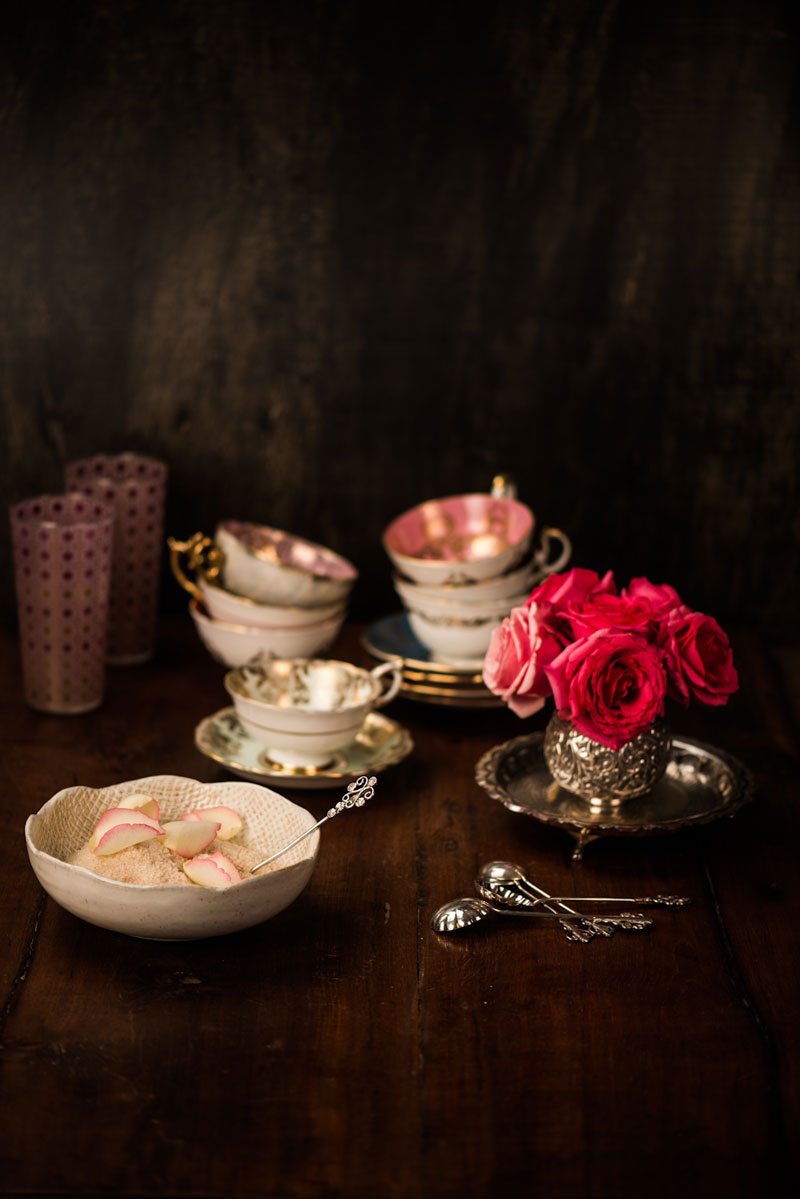 The menus were never too extensive, just varied enough for everyone to catch one or two of their favourites. On the night before the wedding, you probably ate kadambuttus and pandi curry; at the wedding lunch, there was always that magnificent Coorg mutton pulao, otherwise known simply as ‘erachi kool’, with a mor pajji of onions. For dessert, it was always payasa. There might have been an extra treat: a solid square of Mysore Pak, or a Jalebi, fetched all the way from Mysore – but payasa was the dessert of the day. If it was a thick akki payasa, you ate it off your banana leaf plate, licking the sweetness off your fingers.
The menus were never too extensive, just varied enough for everyone to catch one or two of their favourites. On the night before the wedding, you probably ate kadambuttus and pandi curry; at the wedding lunch, there was always that magnificent Coorg mutton pulao, otherwise known simply as ‘erachi kool’, with a mor pajji of onions. For dessert, it was always payasa. There might have been an extra treat: a solid square of Mysore Pak, or a Jalebi, fetched all the way from Mysore – but payasa was the dessert of the day. If it was a thick akki payasa, you ate it off your banana leaf plate, licking the sweetness off your fingers. 
There was another creation you drank out of small cups, made of ground poppy seeds –khaskhas payasa. It was cardamom scented, creamy and smooth, tinged with saffron and scattered with sliced almonds. Its faintly earthy flavour and fragrance, mingled with a luxurious hint of saffron, always went down far too quickly. There never seemed to be enough time to capture its essence.
In my mind, khas khas payasa was always linked with weddings and gatherings, and I never made it at home until a few years ago. It is rich from the thick coconut milk and poppy seed extract that go into it, with a nice crunch from slivered almonds sprinkled on top. Eaten by the spoonful rather than drunk down, it is extravagant and delicious. Saffron always makes me think of roses, so one day I decided to sprinkle dried, edible rose petals over a cupful of khas khas payasa – the result was quite exquisite.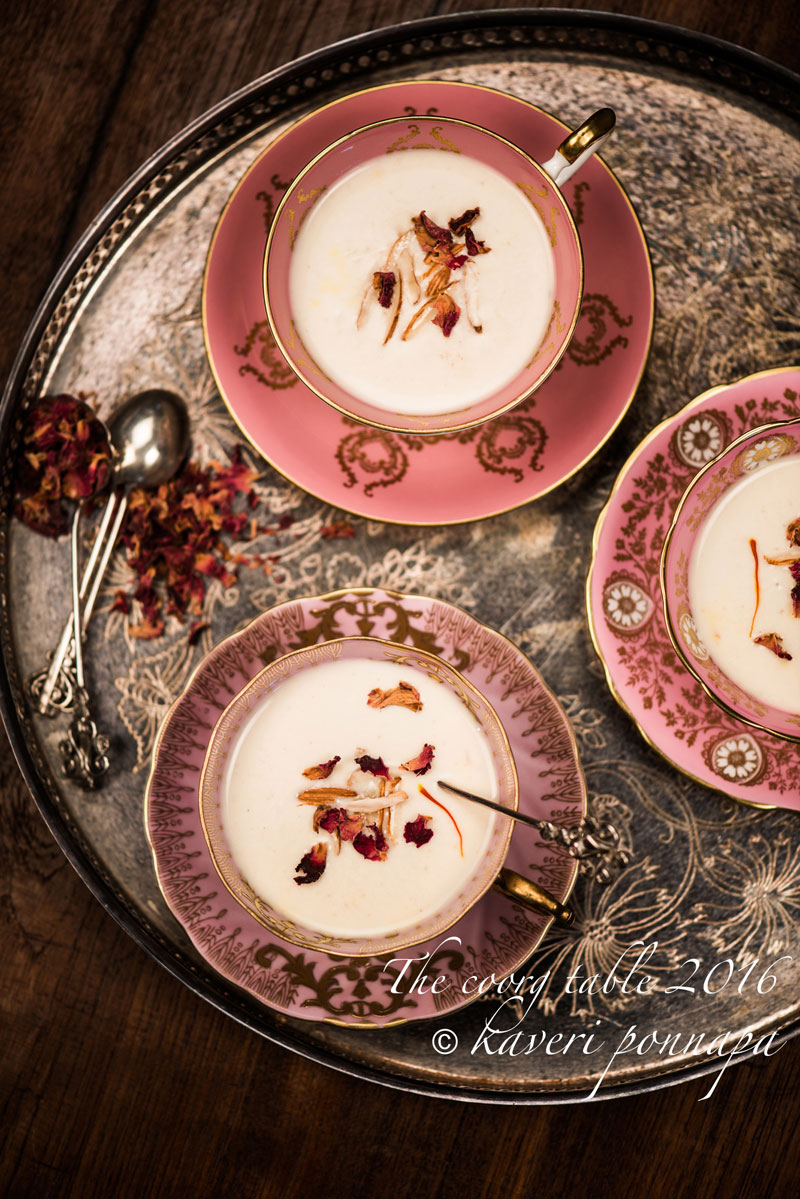 While I was perfecting my version of khas khas payasa, quite unannounced, weddings and gatherings skipped a beat. The crowds are enormous now. Sometimes you miss meeting the parents of the bride and groom in the crush and sea of faces. The spread on the buffet tables is elaborate, carrying the infinite boredom of what we refer to as multi-cuisine. There’s usually an entire counter dedicated to desserts. Everyone eats standing up, or with plates balanced on their laps. They all seem to be in a terrible hurry, there’s no time to talk, because they have so many weddings to attend, often on the same day. Maybe that’s why I just allow the invitations to pile up these days and don’t do much about them. Maybe I’m hoping to join in an old-fashioned gathering one day.
While I was perfecting my version of khas khas payasa, quite unannounced, weddings and gatherings skipped a beat. The crowds are enormous now. Sometimes you miss meeting the parents of the bride and groom in the crush and sea of faces. The spread on the buffet tables is elaborate, carrying the infinite boredom of what we refer to as multi-cuisine. There’s usually an entire counter dedicated to desserts. Everyone eats standing up, or with plates balanced on their laps. They all seem to be in a terrible hurry, there’s no time to talk, because they have so many weddings to attend, often on the same day. Maybe that’s why I just allow the invitations to pile up these days and don’t do much about them. Maybe I’m hoping to join in an old-fashioned gathering one day. 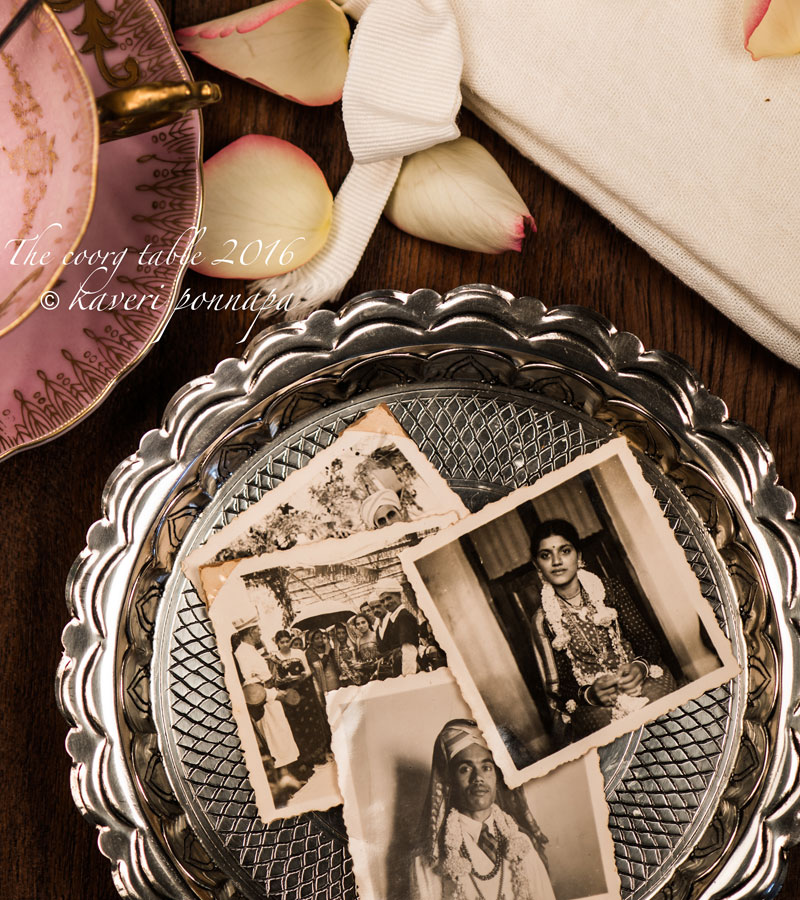
Photo Credits: Nithin Sagi
All Food Styling: Kaveri Ponnapa
Thank you for visiting this page. If you read something that you enjoy, or see an image that you like, please take a moment to write a response. Do look out for the recipes of all the food featured here in my upcoming cookbook.

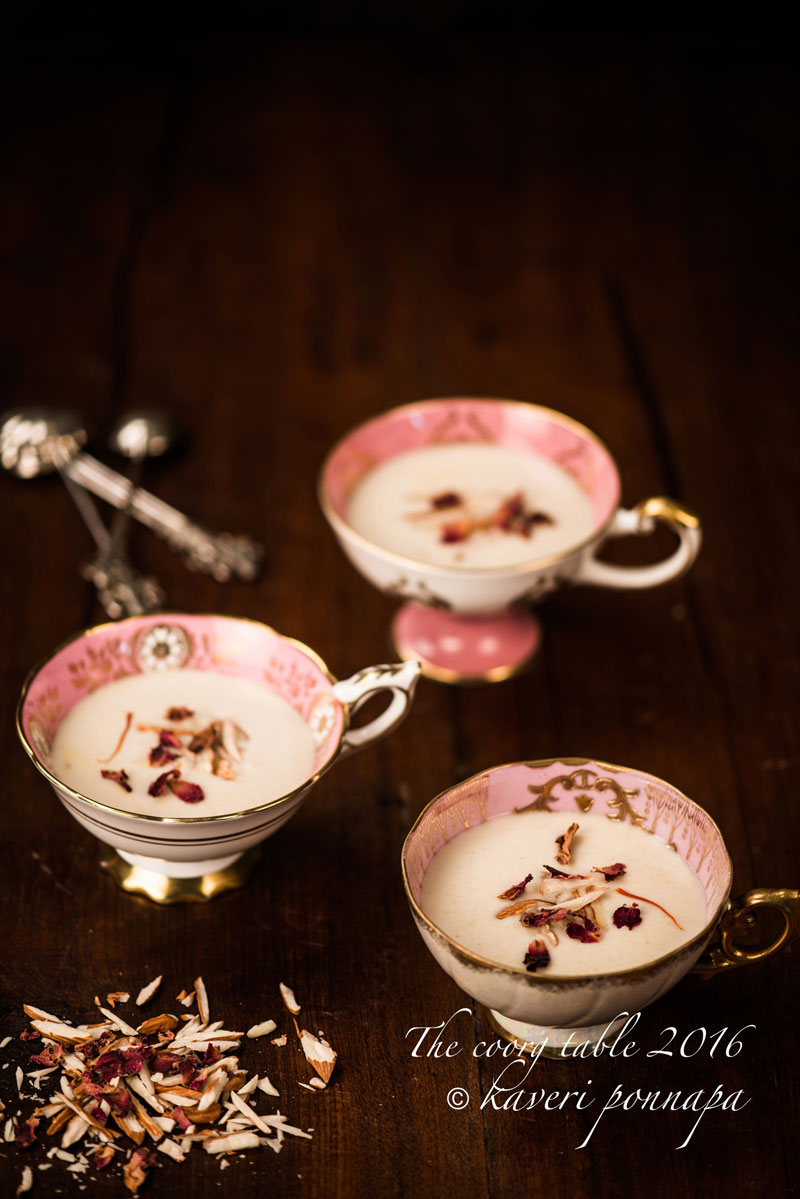

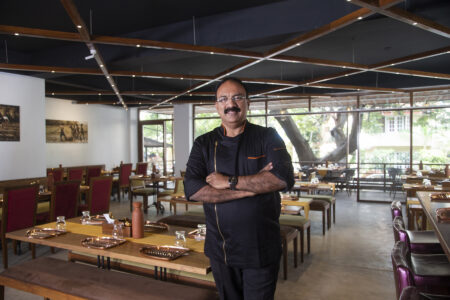
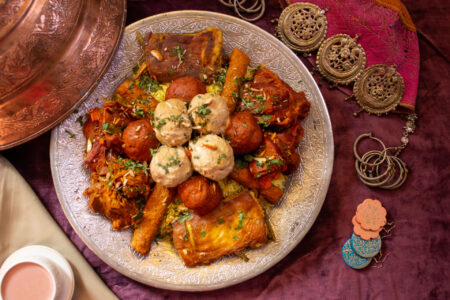
Hi Kaveri,
I too am entranced and transported to another world each time I read your posts …… of smoke filled kitchens with pots of amazing dishes bubbling away on wood fired stoves. Reminds me of all the summers I spent in my ancestral home in Kerala…. the recipes may be different but the experiences are so similar.
Can’t wait to get your book.
Hello Nirmala,
Welcome to The Coorg Table! I am delighted to hear that the posts have rekindled memories of your summers in Kerala, thank you for sharing your experience. I think it really does not matter where we come from, food provides a meeting place, and ultimately brings us all together. Please do keep reading, I would love to hear from you again- and I will post here when my book is out. Kaveri
What an exquisite piece of writing, embroidered with morsels of food and gorgeous photographs. I am entranced.
Thank you Marryam! This is a post I enjoyed writing, and was happy to share. Sadly, that way of cooking and sharing food has all but disappeared.
Hi Kaveri,
I tried your puthari curry and loved it. My friend who happens to be from Coorg tells me she never had this curry 🙂 and I was happy to have told her about it. I love your work and this payasa is totally new to me. I hope to try it.
Hi Teena, welcome, and I’m really delighted that you enjoyed puthari curry. I think it is one of the ‘lost’ dishes that people are making less and less often these days. I too, like your friend, had never tasted it. But I was very fortunate to learn about it from a wonderful lady, as I have written in the post. It has become one of my all-time favourites, rich and tasty. I doubt if I will restrict it to just puthari! Please do keep writing in, I would be happy to hear from you. I hope you’ll try the Cape gooseberry jam, it is irresistible. Warm wishes.Kaveri
Such a lovely article. Enamoured and charmed by the language. Best wishes.
Hello Sagar, thank you very much! I do hope that you will read some of the other posts too, and try out some of the recipes. Best wishes.Kaveri
A food photograph should tell a story and be so good that you want to rush to the kitchen and make the dish immediately… yours are amazing..!
Hi Sharmila, thank you very much! I love this part of my work, as it allows me to indulge my imagination to my heart’s content, trying to evoke a moment. Do keep visiting these pages. Warm wishes.Kaveri
Hi Mrs.Kaveri, I really enjoyed reading your blog. There is so much beauty in your writing, It took my imagination to a different level. I feel proud. Sending you lots of best wishes.
Hi Sushma, thank you so much for your appreciation and good wishes, they mean a lot.It made my day to read what you have written. Please keep visiting these pages, and enjoy the blog, there’s lots more that I will be sharing on these pages. Warm wishes.Kaveri
Yes, In marriages before we used to see home made recipes like coconut taafi, kajjaya, murk etc..but now we are missing those home made items…khas khas payasa wow nice! Very long back I had…I tell my mom to prepare this weekend for me…Thanks for bringing back all the dishes which was fading away slightly in these days..Your narration is always nice to read..we will always eagerly wait for your next recipe it always cherish our memories…Thank You…
Hi Kaverappa, I hope you get a large bowlful of khas khas payasa this weekend. It is such a perfect dish, I could just keep eating it again and again. As for the coconut toffee, chakkalis and other snacks-do keep reading, they are all on their way. Warm wishes.Kaveri